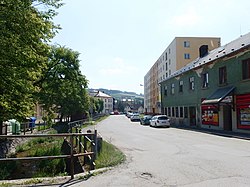Brněnec
Brněnec | |
|---|---|
 Main street | |
| Coordinates: 49°37′39″N 16°31′19″E / 49.62750°N 16.52194°E | |
| Country | |
| Region | Pardubice |
| District | Svitavy |
| First mentioned | 1557 |
| Area | |
| • Total | 6.30 km2 (2.43 sq mi) |
| Elevation | 370 m (1,210 ft) |
| Population (2024-01-01)[1] | |
| • Total | 1,223 |
| • Density | 190/km2 (500/sq mi) |
| Time zone | UTC+1 (CET) |
| • Summer (DST) | UTC+2 (CEST) |
| Postal code | 569 04 |
| Website | obec |
Brněnec (German: Brünnlitz) is a municipality and village in Svitavy District in the Pardubice Region of the Czech Republic. It has about 1,300 inhabitants.
Administrative parts
[edit]The villages of Chrastová Lhota, Moravská Chrastová and Podlesí are administrative parts of Brněnec.
Geography
[edit]Brněnec is located about 15 kilometres (9 mi) south of Svitavy and 45 km (28 mi) north of Brno. It lies in the Svitavy Uplands. The highest point is at 555 m (1,821 ft) above sea level. The municipality is situated at the confluence of the Svitava River and the stream Chrastovský potok; the built-up area is located in the valleys of these two watercourses. The Svitava River forms here the historical border between Bohemia and Moravia.
History
[edit]Next to an old trade route, the settlement of Moravská Chrastová was founded after 1200 by monks from the monastery in Litomyšl. Moravská Chrastová was first mentioned in a document from 1323. The first written mention of Brněnec is in the act of partition of the Svojanov estate from 1557. Until the 18th century, it was a part of Bělá nad Svitavou. After the Löw-Beer family founded here a textile factory, the importance of Brněnec grew.[2]
In 1938, the municipality was annexed by Nazi Germany and administered as part of Reichsgau Sudetenland. After World War II, the Germans were expelled.
Schindler factory
[edit]

The Löw-Beer Jewish family founded a textile producing company in the 1810s, and in 1855 rebuilt an old paper mill in Brněnec into the textile factory. In 1938, it was taken over by Germans.[3]
In 1944, Oskar Schindler relocated his German Enamelware Factory and the associated prison camp of 1,200 Jewish forced labourers from Kraków to a munitions factory acquired by him in Brněnec. The Jewish workforce thus escaped transport to the extermination camps and was liberated along with the rest of the municipality on 10 May 1945 by the Red Army, after the factory had been fully operational for seven months. As of 2016, the Endowment Fund for the Memorial of the Shoah and Oskar Schindler is engaged in turning the ruins of the factory into a museum.[4]
Demographics
[edit]
|
|
| ||||||||||||||||||||||||||||||||||||||||||||||||||||||
| Source: Censuses[5][6] | ||||||||||||||||||||||||||||||||||||||||||||||||||||||||
Transport
[edit]The I/43 road (part of the European route E461) from Brno to Svitavy passes through the municipality.
Moravská Chrastová is located on the railway line heading from Brno to Česká Třebová.[7]
Sights
[edit]
The most important monument is the Evangelical church in Moravská Chrastová. It was built in the Arts and Crafts style in 1889.[8] Other sights include the Chapel of Saint Isidore in Moravská Chrastová from 1855 and a belfry in Brněnec.[2]
Notable people
[edit]- František Bartoš (1905–1973), composer, music critic and musicologist
- Oskar Schindler (1908–1974), World War II-era industrialist who saved 1,200 Jewish lives
References
[edit]- ^ "Population of Municipalities – 1 January 2024". Czech Statistical Office. 2024-05-17.
- ^ a b "Historie" (in Czech). Obec Brněnec. Retrieved 2023-06-27.
- ^ "Soubor bývalé textilní továrny" (in Czech). National Heritage Institute. Retrieved 2021-10-15.
- ^ Day, Matthew (2016-08-17). "Czech factory once home to 1,200 Jews saved by Oskar Schindler to be turned into a Holocaust museum". The Telegraph. Retrieved 2016-09-07.
- ^ "Historický lexikon obcí České republiky 1869–2011" (in Czech). Czech Statistical Office. 2015-12-21.
- ^ "Population Census 2021: Population by sex". Public Database. Czech Statistical Office. 2021-03-27.
- ^ "Detail stanice Moravská Chrastová" (in Czech). České dráhy. Retrieved 2024-06-28.
- ^ "Evangelický kostel" (in Czech). National Heritage Institute. Retrieved 2023-06-27.



